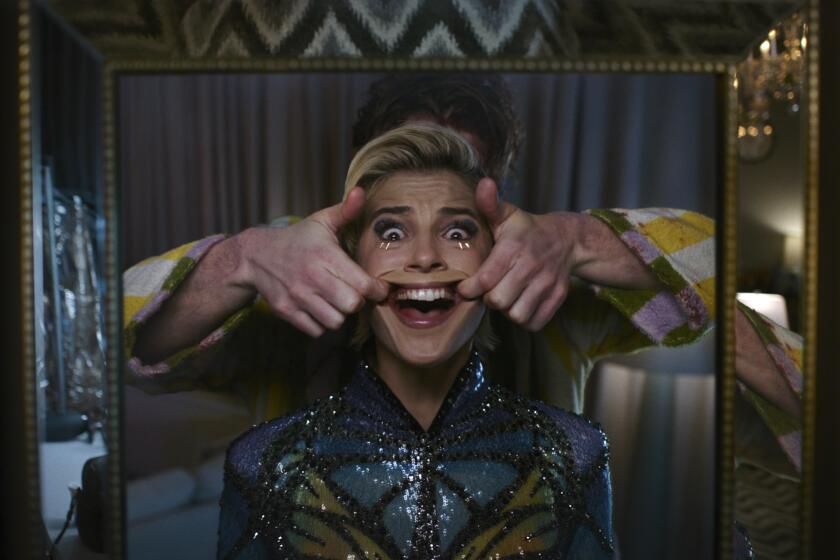Commentary: Hollywood’s glaring problem: White actors playing Asian characters
Two images released last week from upcoming films highlight one glaring Hollywood problem.
The first was the visage of Tilda Swinton in the debut trailer for Marvel’s “Doctor Strange,” in which the actress — shorn and wearing the white robes of a Tibetan monk — plays the Ancient One. In the “Doctor Strange” comics, the Ancient One is like Dumbledore meets Yoda: When the shattered former surgeon Stephen Strange makes his way deep into the Himalayas looking for enlightenment and redemption, he becomes a student of the mystically adept, absolutely Asian Ancient One.
A few days later, Paramount unveiled the first image from its 2017 adaptation of “Ghost in the Shell,” the classic Japanese animated film adapted from Japanese manga. Scarlett Johansson is playing the Major, a law enforcement officer who has subjected herself to so many cybernetic upgrades that she is more machine than human. In the comics and movies, her name is Motoko Kusanagi, and as that most definitely implies, the character was written as Asian.
Given Hollywood’s tragic, systemic and apparently addictive history of casting white actors to play characters of Asian origin, this sort of thing is nothing new. As far back as 1915 — when Mary Pickford starred in “Madame Butterfly” — producers and directors have had no problem casting white actors and actresses as people of color. John Wayne, Katharine Hepburn, Anthony Quinn, Boris Karloff, Fred Astaire, Marlon Brando, Alec Guinness, Mickey Rooney, Joel Grey, Linda Hunt, Max von Sydow, Peter Sellers, David Carradine, Mike Myers — and many, many others — have played characters of Asian descent. (And judging by the incredibly ill-conceived jokes at this year’s Oscar telecast, the devaluing of Asian identity isn’t going anywhere.)
As American society got “woke,” some of us realized that this kind of thing was not OK. Still, it continued. M. Night Shyamalan cast white actors as the heroes for his adaptation of the inherently Asian fantasy TV show “Avatar: The Last Airbender.” Lionsgate ran into a buzz saw of controversy when its first trailer for “Gods of Egypt” showed white actors playing all of the gods of Egypt. The studio was forced to apologize in a press release: “We recognize that it is our responsibility to help ensure that casting decisions reflect the diversity and culture of the time periods portrayed.”
But even more troubling and insidious is a newer phenomenon of racial erasure — when in the process of adaptation, filmmakers remove the original racial identities of the characters in favor of … something else. Something Hollywood (wrongly, some might say) perceived to be box-office safe.
For Tom Cruise’s “Edge of Tomorrow” — based on the Japanese novel “All You Need Is Kill” — the protagonist was named William Cage, a departure from the novel’s Keiji Kiriya. In “The Martian,” Chewitel Ejiofor plays NASA bigwig Vincent Kapoor — a character who in Andy Weir’s novel is named Venkat Kapoor.
Which brings us back to Johansson. That first image of “Ghost in the Shell” identifies her only as the Major, carefully not revealing the character’s actual full name. Will she still be playing a character with an Asian name, or has it been rewritten for racial erasure? And ultimately which is worse: Hollywood not casting Asians to play Asians or Hollywood pretending that Asians don’t exist in the first place?
It’s also worth noting that Johansson is a key player in the Marvel Cinematic Universe and that her most recent starring vehicle, 2014’s “Lucy,” made $463 million worldwide. There are no Asian actors who have demonstrated that kind of global pull. At the end of the day, the only race Hollywood cares about is the box office race.
When Ejiofor was cast in “The Martian” after Irrfan Khan turned down the role, it was cited as a case of getting the right actor for the role, regardless of ethnicity. The same logic is being used to defend Swinton’s casting in “Doctor Strange.” And, yeah, there is no one on Earth who conveys “otherworldly fluidity” quite like Swinton, who seems cut from alien gossamer.
“Colorblind casting” is the term Hollywood uses to explain an attempt to diversify the faces we see on-screen. You hear the term when casting directors are willing to look at anyone, regardless of race, to fill a role that had been initially written as white — because the default in Hollywood is white.
But as hypocritical as it might seem, colorblind casting doesn’t go the other way. The goal is to make the faces we see on-screen more accurately represent the faces we see in the world — a world that is increasingly affected by (and in Hollywood’s case, dominated by) Asian influences.
Look at it this way: Take two children. One of them has 1,000 action figures, while the other has just one. If you take a single figure away from that first child, it is possible, if not probable, that he or she won’t even notice it’s gone. And even if he or she did complain, any sane person would explain to that child the virtues of sharing, of generosity.
Now, if you turned to that child with the solitary toy and tried to take it away, that child would be devastated. That toy might well be his or her lifeline to imagination, to hope, to the idea that play could unlock something within that he or her didn’t even know existed.
If we all can agree that representation matters, then white people are impossibly well represented — while seeing an Asian face in the movies is bordering on the impossible. And apparently it’s getting more impossible every day.
ALSO
After #OscarsSoWhite, Academy clears the air about new membership rules
Oscar Isaac on ‘Star Wars: Episode VIII’: ‘It feels like we’re making an independent film’
Alibaba Pictures invests in Paramount’s new ‘Star Trek,’ ‘Ninja Turtles’ films
‘Riddick’ director to blast off with ‘Ice Moon Rising,’ a space film with a China element
‘The Jungle Book’ lands second highest April opening ever with $103.6 million
More to Read
Only good movies
Get the Indie Focus newsletter, Mark Olsen's weekly guide to the world of cinema.
You may occasionally receive promotional content from the Los Angeles Times.











